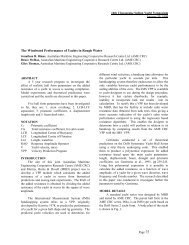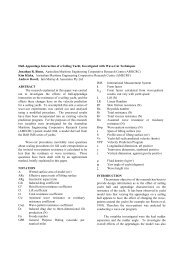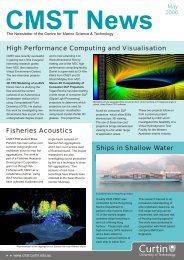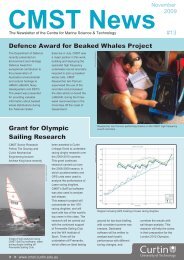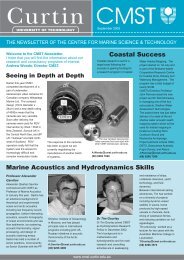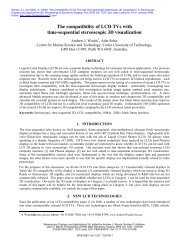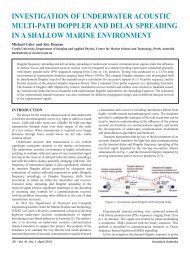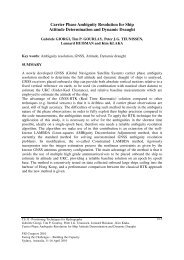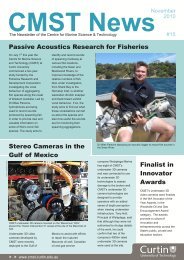Blue whale calling in the Rottnest trench-2000, Western ... - ANP
Blue whale calling in the Rottnest trench-2000, Western ... - ANP
Blue whale calling in the Rottnest trench-2000, Western ... - ANP
You also want an ePaper? Increase the reach of your titles
YUMPU automatically turns print PDFs into web optimized ePapers that Google loves.
source level of <strong>the</strong> type II signal <strong>in</strong> each block was, <strong>the</strong> transmission loss estimates at 24 Hz for<br />
all comb<strong>in</strong>ations of:<br />
• <strong>the</strong> s<strong>in</strong>gle range estimate (Table 3),<br />
• <strong>the</strong> eight bathymetry paths;<br />
• a 200 m and 75 m thick Leeuw<strong>in</strong> current;<br />
• and a source depth of 20 and 40 m<br />
were added to <strong>the</strong> appropriate mean squared pressure of <strong>the</strong> type II signal to give 224 'possible'<br />
source levels. Note that some are erroneous values s<strong>in</strong>ce eight bathymetry tracks, two source<br />
depths and two sound speed profiles were used, yet for each block only one comb<strong>in</strong>ation is<br />
correct. Propagation of only <strong>the</strong> 20-26 Hz signal was considered, as this spectral section of <strong>the</strong><br />
type II signal was consistently 10 dB or greater than <strong>the</strong> <strong>in</strong>put from o<strong>the</strong>r frequencies, hence<br />
contributed all <strong>the</strong> effective signal energy (section 3.1.3). The frequency distribution of <strong>the</strong>se<br />
'possible' source levels was plotted as per Figure 23 and <strong>the</strong> distribution b<strong>in</strong> with <strong>the</strong> highest<br />
count taken as an estimate of <strong>the</strong> type II source level, or 183 dB re 1μPa mean squared pressure<br />
at one metre.<br />
This was considered a crude estimate but s<strong>in</strong>ce <strong>the</strong>re was no valid way of f<strong>in</strong>d<strong>in</strong>g <strong>the</strong> true source<br />
level for each call without determ<strong>in</strong><strong>in</strong>g which bathymetry path <strong>the</strong> animal was along, and that an<br />
error <strong>in</strong> <strong>the</strong> range estimate of only a few hundred metres could potentially give a large difference<br />
<strong>in</strong> transmission loss, it was considered reasonable. The value is higher than <strong>the</strong> source level<br />
estimate of D'Spa<strong>in</strong> et al (1995) of 169 dB re 1μPa msp, or Thode et al (<strong>2000</strong>) of 180 dB re 1μPa<br />
msp, but less than that of Cumm<strong>in</strong>gs and Thompson (1971) of 188 dB re 1μPa msp, but <strong>the</strong>se<br />
estimates are from different blue <strong>whale</strong> stocks us<strong>in</strong>g different methods.<br />
The type II component source level estimate of 183 dB re 1μPa mean squared pressure at one<br />
metre has been used below <strong>in</strong> range estimation.<br />
Table 3: Measured relative arrival times and range estimates with predicted arrival times, for seven sets of blue<br />
<strong>whale</strong> calls.<br />
block path 2 / path 3 (where<br />
available) travel time,<br />
relative to path 1<br />
(ms)<br />
horizontal<br />
range estimate<br />
(m)<br />
predicted path 2 / path 3 /<br />
path 4 (where available)<br />
arrival time - relative to path<br />
1 (ms)<br />
10 150 3550 150 / 418 / 777 121.4<br />
24 120 4750 120 / 331 / 625 122.7<br />
33 170 / 430 3050 171 / 471 123.8<br />
43 100 6200 100 / 269 / 506 121.6<br />
335 210 / 550 2350 212 / 571 128.8<br />
337 223 / 596 2200 223 / 596 125.7<br />
338 254 1850 256 / 657 128.8<br />
26<br />
measured type II<br />
component level<br />
(msp - dB re<br />
m Pa)<br />
3.4) Transmission of blue <strong>whale</strong> calls to bluey site<br />
All propagation calculations concentrated on <strong>the</strong> type II component only, as this was <strong>the</strong><br />
component with <strong>the</strong> highest source level and which appeared best at all ranges <strong>in</strong> <strong>the</strong><br />
spectrogram plots. Us<strong>in</strong>g <strong>the</strong> transmission loss and source level estimate as derived above, a plot<br />
of <strong>the</strong> result<strong>in</strong>g received level for <strong>the</strong> type II component about <strong>the</strong> bluey logger location, for <strong>the</strong><br />
bottomed receiver, source at 40 m depth and a 75 m deep Leeuw<strong>in</strong> current is shown on Figure<br />
24 (us<strong>in</strong>g <strong>the</strong> eight 45 o transmission loss tracks and <strong>in</strong>terpolated between).



